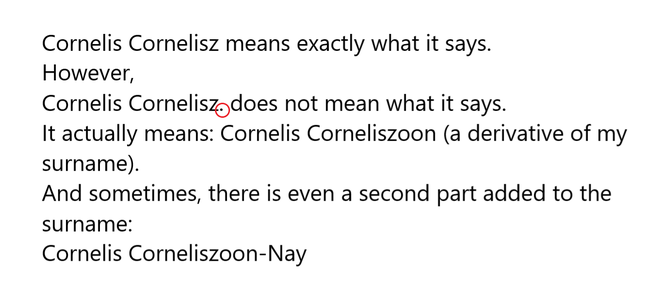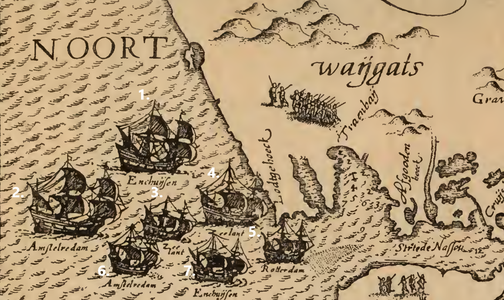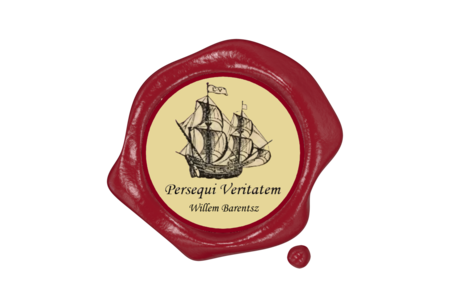- Joined
- Jan 9, 2020
- Messages
- 10,540
- Points
- 938

Hello Everyone
If there is one thing that really bothers me and that I would dearly like to get to the bottom of, then it is the whole issue with regards to the ship's name. De Veer’s journal sometimes varies considerably – especially when working with different editions. This is confusing enough, but added to that are the intricacies of old-Dutch - plus the fact that they did not care one iota about spelling.
For instance: The name Cornelis and surname Cornelisz mean exactly that – the person is called Cornelis Cornelisz. But when that same surname gets a full-stop behind it, the whole thing changes. Cornelis Cornelisz. means Cornelis Corneliszoon. And many times there is also a second part of the surname which is not written down but implied, such as Cornelis Corneliszoon-Nay. Thus when you read Cornelis Cornelisz, and then Cornelis Nay, you would assume we are talking about two different people – nope sir – one and the same!

The reason why I focus on this, is because Cornelis Cornelisz. or Cornelis Corneliszoon-Nay was the captain onboard De Swane - one of the three ships that took part in the First Expedition of Barentsz in 1594. So, whilst Van der Veer calls the ship "De Swane" in his journal; Ab calls it "De Zwane" in his book. In any case, it means "The Swan" in English and is a fancied name of those who believe that Barentsz ship was called "De Witte Zwaen" Confused? Good - so am I.
Confused? Good - so am I.
In any case, when we look at the 1594 Expedition, we know there were three ships:
1. De Swane which was captained by Cornelis Corneliszoon-Nay from Enkhuizen. Of this ship, I have the article letter issued to Corneliszoon-Nay which stipulates the names of the crew members, their positions, their salaries and exactly what the ship was issued with - very detailed. As supercargo (merchantman) and interpreter on board the Swan went Francois de la Dale who had resided several years in Bussia, and as additional interpreter, " Meester" Christoffel Splindler, a Slavonian by birth, who had studied at the university of Leyden.
2. The other vessel was the Mercurius (Mercury) under the command of Brant Ysbrantszoon, otherwise Brant Tetgales, a skillful and experienced sailor, with Claes Corneliszoon as his mate or under-pilot; both being likewise natives of Enkhuysen. This was the ship on which Barentsz sailed in 1594. On board the Mercurius the supercargo was Jan Huyghen van Linschoten, who was likewise engaged to keep a journal of their progress.
3. The third ship was originally a fishing vessel which accompanied the Mercurius. Of this ship we have absolutely no further detail - so in the words of Meatloaf, I guess I will have to say "Two out of three ain't bad"!
The Ships of the 1595 Expedition
The fleet consisted of seven vessels, namely, two from Zeelandt, two from Enkhuysen, two from Amsterdam (which city, in consequence of the want of success of Barents's first voyage was now willing to take part in the undertaking of the other ports), and one from Rotterdam.
Zeelandt's Ships:
De Griffioen (The Griffen) of 100 lasten with Cornelis Corneliszoon-Nay (who captained De Swane the previous year, as Admiral/Superintendent. Willem Barentsz though was opposed to this appointment. In his book, Ab lists all the modifications done to this ship in preparation for the trip, in detail. Interestingly, he lists it as 86 lasten.
De Swane (The Swan): This was the same ship that also went on the 1594 expedition. She was listed as 50 lasten (according to Ab, 40 lasten) and was under the command of Lambert Gerritszoon-Oom. Ab also lists the modifications that this ship underwent in preparation for the trip.
Enkhuyzen's Ships:
De Hoope (The Hope): War pinnace 100 lasten and captained by Brandt Ysbrandtzsoon Tetgales (Vice Admiral).
De Mercurius (The Mercury) NOTE: This was NOT the same ship as the Mercurius which took part in the first expedition). . She was listed as being of 50 lasten and was captained by Thomas Willemszoon
Amsterdam's Ships:
De Windhond (The Greyhound): A brand-new war pinnace of 100 lasten with Cornelis Jacobszoon as skipper. This was also the ship that Willem Barentsz sailed on during the 1595 expedition.
De Mercurius (The Mercury): This was indeed the Mercurius of the previous journey. She was classified as a "jacht" of 50 lasten and was captained this time by Harman Janszoon
Rotterdam's Ship:
An unnamed "jacht" of 20 lasten captained by Hendrick Hartman.

Based on this drawing which clearly shows the differences in size between the ships as well as their area/Admiralty of origin underneath each ship, we can actually identify them as:
1. De Hoope
2. De Windhond
3. De Swane
4. De Griffioen
5. Unnamed jacht from Rotterdam
6. The original Mercurius
7. The "new" Mercurius
So at the end of all this, and with such detailed information available on the ships of the first and second expeditions, how is it possible that NO information exists on the ships' names of the Third Expedition (other than them being of 50 and 30 lasten respectively)?
If there is one thing that really bothers me and that I would dearly like to get to the bottom of, then it is the whole issue with regards to the ship's name. De Veer’s journal sometimes varies considerably – especially when working with different editions. This is confusing enough, but added to that are the intricacies of old-Dutch - plus the fact that they did not care one iota about spelling.
For instance: The name Cornelis and surname Cornelisz mean exactly that – the person is called Cornelis Cornelisz. But when that same surname gets a full-stop behind it, the whole thing changes. Cornelis Cornelisz. means Cornelis Corneliszoon. And many times there is also a second part of the surname which is not written down but implied, such as Cornelis Corneliszoon-Nay. Thus when you read Cornelis Cornelisz, and then Cornelis Nay, you would assume we are talking about two different people – nope sir – one and the same!

The reason why I focus on this, is because Cornelis Cornelisz. or Cornelis Corneliszoon-Nay was the captain onboard De Swane - one of the three ships that took part in the First Expedition of Barentsz in 1594. So, whilst Van der Veer calls the ship "De Swane" in his journal; Ab calls it "De Zwane" in his book. In any case, it means "The Swan" in English and is a fancied name of those who believe that Barentsz ship was called "De Witte Zwaen"
 Confused? Good - so am I.
Confused? Good - so am I.In any case, when we look at the 1594 Expedition, we know there were three ships:
1. De Swane which was captained by Cornelis Corneliszoon-Nay from Enkhuizen. Of this ship, I have the article letter issued to Corneliszoon-Nay which stipulates the names of the crew members, their positions, their salaries and exactly what the ship was issued with - very detailed. As supercargo (merchantman) and interpreter on board the Swan went Francois de la Dale who had resided several years in Bussia, and as additional interpreter, " Meester" Christoffel Splindler, a Slavonian by birth, who had studied at the university of Leyden.
2. The other vessel was the Mercurius (Mercury) under the command of Brant Ysbrantszoon, otherwise Brant Tetgales, a skillful and experienced sailor, with Claes Corneliszoon as his mate or under-pilot; both being likewise natives of Enkhuysen. This was the ship on which Barentsz sailed in 1594. On board the Mercurius the supercargo was Jan Huyghen van Linschoten, who was likewise engaged to keep a journal of their progress.
3. The third ship was originally a fishing vessel which accompanied the Mercurius. Of this ship we have absolutely no further detail - so in the words of Meatloaf, I guess I will have to say "Two out of three ain't bad"!

The Ships of the 1595 Expedition
The fleet consisted of seven vessels, namely, two from Zeelandt, two from Enkhuysen, two from Amsterdam (which city, in consequence of the want of success of Barents's first voyage was now willing to take part in the undertaking of the other ports), and one from Rotterdam.
Zeelandt's Ships:
De Griffioen (The Griffen) of 100 lasten with Cornelis Corneliszoon-Nay (who captained De Swane the previous year, as Admiral/Superintendent. Willem Barentsz though was opposed to this appointment. In his book, Ab lists all the modifications done to this ship in preparation for the trip, in detail. Interestingly, he lists it as 86 lasten.
De Swane (The Swan): This was the same ship that also went on the 1594 expedition. She was listed as 50 lasten (according to Ab, 40 lasten) and was under the command of Lambert Gerritszoon-Oom. Ab also lists the modifications that this ship underwent in preparation for the trip.
Enkhuyzen's Ships:
De Hoope (The Hope): War pinnace 100 lasten and captained by Brandt Ysbrandtzsoon Tetgales (Vice Admiral).
De Mercurius (The Mercury) NOTE: This was NOT the same ship as the Mercurius which took part in the first expedition). . She was listed as being of 50 lasten and was captained by Thomas Willemszoon
Amsterdam's Ships:
De Windhond (The Greyhound): A brand-new war pinnace of 100 lasten with Cornelis Jacobszoon as skipper. This was also the ship that Willem Barentsz sailed on during the 1595 expedition.
De Mercurius (The Mercury): This was indeed the Mercurius of the previous journey. She was classified as a "jacht" of 50 lasten and was captained this time by Harman Janszoon
Rotterdam's Ship:
An unnamed "jacht" of 20 lasten captained by Hendrick Hartman.

Based on this drawing which clearly shows the differences in size between the ships as well as their area/Admiralty of origin underneath each ship, we can actually identify them as:
1. De Hoope
2. De Windhond
3. De Swane
4. De Griffioen
5. Unnamed jacht from Rotterdam
6. The original Mercurius
7. The "new" Mercurius
So at the end of all this, and with such detailed information available on the ships of the first and second expeditions, how is it possible that NO information exists on the ships' names of the Third Expedition (other than them being of 50 and 30 lasten respectively)?
Last edited by a moderator:





 All I can say to that is Amen! It does indeed look like the articles are biased towards the Master, but it does offer the kind of protection to individuals so vital on a ship.
All I can say to that is Amen! It does indeed look like the articles are biased towards the Master, but it does offer the kind of protection to individuals so vital on a ship.
